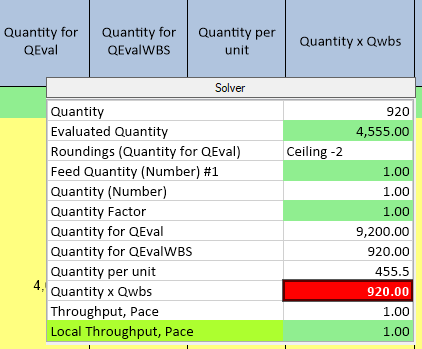Use Case
Within the public works and the construction industry, machines must be rented, e.g., asphalt paver, excavator, bulldozer, ...
From the capacity of the bucket, blade, ..., the contractor evaluates the pace at which they can provide a particular service (e.g. 100 cb ft a day). From the task demand (e.g. 1,000 cb ft to excavate), QDV7 calculates the usage time (10 days).
The various cost components can be handled together as a set of Minutes: the header quantity is factored to the underlying rows. If other machines are used after the main machine, for example if an bulldozer must clear the shoveled debris and a truck must carry them away, a wrapping set is necessary:

Implementation
QDV7 offers a predefined free field: Throughput, Pace that applies to the headers of (main or nested) sets, and to the rows at the level of the nested set header.
Its unit is also a predefined free field (text).
For a greater clarity, you can rename the 'Quantity per unit' native field 'Quantity per unit of parent'.
Procedure
1.In the Fields Manager>Free fields, add a new field and herein click in the first column, right click and select Special columns>Throughput, Pace
2.Similarly, add the Units of Throughput field
3.In the Minutes view, insert the Quantity per unit, Throughput, Pace, and Units of Throughput columns
4.Enter the Throughput, Pace (the default value equal to 1 is not displayed)
5.Enter the quantity either in the "Quantity per unit of parent" column. The Quantity column is derived by dependencies, hereunder in red:
▪at the root (no parent), the quantity is a duration, the quantity per unit of parent (meaningless in a regular set) is then the cubing performed by the set (there is no direct cost)
▪the quantity for the parent is factored to the quantity per unit of parent of a child:
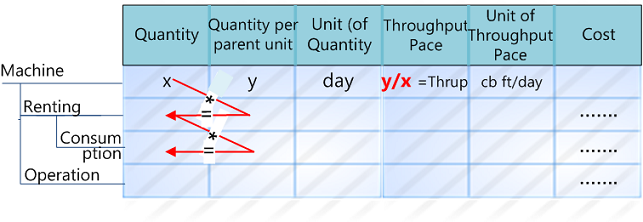
This feature can be used within the Database of the Estimate. The quantity per unit of parent is arbitrary therein; it will be chosen in the Minutes view.
Recursion
This is exemplified in Sample_With_Inheritance_Of_Throughput_Pace.qdv where two machinery sets are created in the database:
▪a stand-alone set, without clearing and carrying away of debris
▪a wrapping set where the stand-alone set is nested, and that includes the clearing and carrying away of debris respectively a bulldozer and a truck at daily or unit fixed rate.
Here, the bulldozer is more efficient than the excavator; hence, the clearing is used as parent. The ratio of the throughputs dictates the relative usage duration of the excavator:
1 day |
Bulldozer throughput |
|
|
0
1 day |
Excavator throughput |
|
|
2 days |
Excavator throughput |
|
cb ft/day |
|
< unit of debris clearing > |
|
|
In the database of the estimate, the quantity per unit of parent of direct children is:
▪identical to the one of the parent for the excavator, because the quantity of the unit of clearing is 1
▪equal to 1 for the more efficient machine (bulldozer) because it defines the unit of clearing:
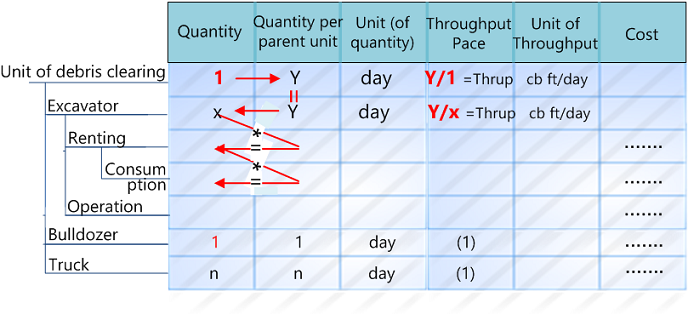
In the Minutes view, the cubing to dig out (27 210 m3) is the task quantity. This quantity applies to the quantity per unit of parent. The wrapping set must dig out 1 m3, hence its quantity per unit of parent is 1. The input quantity derives from it; it is not equal to 1 anymore, therefore y ≠ Y.
The cubings for the machine alone and the machine with clearing of debris are generally different.
To show the two sets in one section of Minutes, which means their quantities are factored by one WBS Quantity, we must distinguish the two sets using a flag (of text type) named for example 1/Q (Q = WBS Quantity).
In the Minutes view, wherever you tick the 1/Q flag (standalone set), the Calculated Quantity is the Quantity divided by the WBS Quantity. Elsewhere it is the Quantity.
The columns meant for input are in
▪light green in the database
▪yellow in the Minutes view.
NOTES
- For purpose of comparison, we have created in addition in the Minutes view the sets without entering a throughput. The default value, invisible, is 1, which leads to other results
- The database of the estimate can also be used to centralize information, such as the Overall Cost, a free field, product of the Number of occurrences in the estimate by the unit cost.
Local Throughput
Unlike the Throughput, Pace field, Local Throughput is entered in the Minutes view (in the set header). Both can be used together: enter a local field to derogate from what the base field demands. This makes most sense in a nested set in the database of the estimate.
Like in the Sample_With_Inheritance_Of_Throughput_Pace.qdv example, we name them here Base Throughput and (Local) Throughput.
The check icon denotes the cells where a value can be entered. In the example, a local value is entered in the database of the estimate to diminish the renting duration.
Alternative: Quantity factor or Percent on quantity described in Quantities.
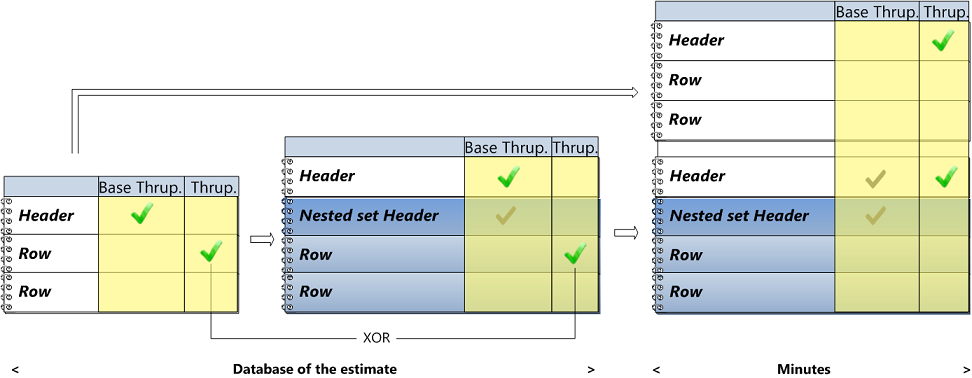
In a simple set, the computations are as follows:
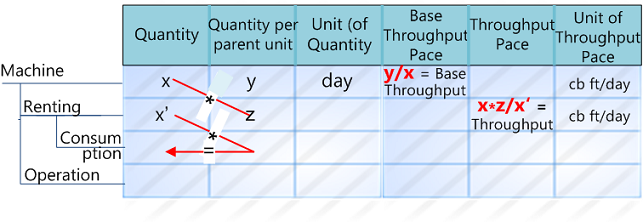
Extension
In addition the quantity can be calculated through a formula as described in How to Empower the Minutes with Quantity Calculation Capabilities.
The solver described in Details of Calculation can adjust the Throughput field:
